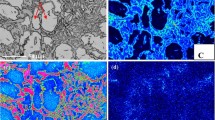Conclusion
As the result of comparison of the service properties of cast magnetic abrasive powders with the same type of structure but different physicochemical properties of the constituents an evaluation was made of the abrasive properties of the latter in polishing of various materials. It was shown that by changing practically only the composition of the solid solution or of the eutectic of the ferromagnetic matrix of the magnetic abrasive powder it is possible to influence both the weight removed and the finish of the polished surface. Similarly the composition of the abrasive inclusions even with the same microhardness may significantly change the polishing indices.
Comparative tests of the carbide- and boride-containing powders showed the advantages of the first in polishing of constructional steel and of the second in polishing of stainless steel and titanium and aluminum alloys.
Similar content being viewed by others
Literature cited
V. E. Oliker, A. F. Zhornyak, V. Ya. Shlyuko, et al., “The formation of the structure of magnetic abra-sive materials from iron-carbon molten mixtures alloyed with carbide-forming elements,” Poroshk. Metall., No. 2, 76–84 (1983).
V. E. Oliker, A. F. Zhornyak, V. Ya. Shlyuko, et al., “The influence of the structure of a magnetic abrasive material on its life in polishing of metals,” Poroshk. Metall., No. 3, 98–101 (1982).
F. Yu. Sakulevich.and L. M. Kozhuro, Three-dimensional Magnetic-Abrasive Working [in Russian], Nauka i Tekhnika, Minsk (1978).
Yu. N. Taran and V. I. Mazur, The Structure of Eutectic Allyos [in Russian], Metallurgiya, Moscow (1978).
V. L. Yupko, Yu. A. Guslienko, N. I. Monastyreva, and T. N. Dvernikova, “Features of the wetting of certain refractory compounds by molten materials of eutectic composition,” Proshk. Metall., No. 3, 52–54 (1983).
G. V. Samsonov, “New abrasive materials in grinding and finishing,” Poroshk. Metall, No. 7, 73–82 (1973).
A. M. Vul'f, The Machining of Metals [in Russian], Mashinostroenie, Leningrad (1973).
E. M. Trent, The Machining of Metals [in Russian], Mashinostroenie, Moscow (1980).
G. V. Samsonov, T. I. Serebryakova, and V. A. Neronov, Borides [in Russian], Atomizdat, Moscow (1975).
B. Aronsson and I. Engström, “X-ray investigations on Me-Si-B systems (M-Mn, Fe, Co). II. Some features of the Fe-Si-B and Mn-Si-B systems,” Acta Chem. Scand.,14, 1403–1413 (1960).
L. M. Kozhuro and N. S. Khomich, “The polishability of materials by magnetic abrasive polishing,” in: Magnetic Abrasive Polishing of Parts: Proceedings of the Republic Scientific and Technical Conference (Minsk, October 1976). Summaries of Papers [in Russian], Minsk (1976), pp. 54–64.
F. Yu. Sakulevich, Fundamentals of Magnetic Abrasive Machining [in Russian], Nauka i Tekhnika, Minsk (1981).
B. I. Kostetskii, I. G. Nosovskii, A. K. Karaulov, et al., The Surface Strength of Materials in Rubbing [in Russian], Tekhnika, Kiev (1976).
B. I. Kostetskii, Friction, Lubrication, and Wear in Machines [in Russian], Tekhnika, Kiev (1970).
H. J. Goldschmidt, Interstitial Alloys, Plenum Publ. (1968).
I. S. Koifman, T. V. Egorshina, and G. V. Laskova, “X-ray diffraction analysis of borocementite,” Metalloved. Term. Obrab. Met., No. 2, 59–60 (1969).
Author information
Authors and Affiliations
Additional information
Translated from Poroshkovaya Metallurgiya, No. 9(273), pp. 71–75, July, 1985.
Rights and permissions
About this article
Cite this article
Oliker, V.E., Zhornyak, A.F., Gridasova, T.Y. et al. Functional role of the structural constituents of the particles of magnetic abrasive powder. Powder Metall Met Ceram 24, 724–728 (1985). https://doi.org/10.1007/BF00792173
Received:
Issue Date:
DOI: https://doi.org/10.1007/BF00792173




